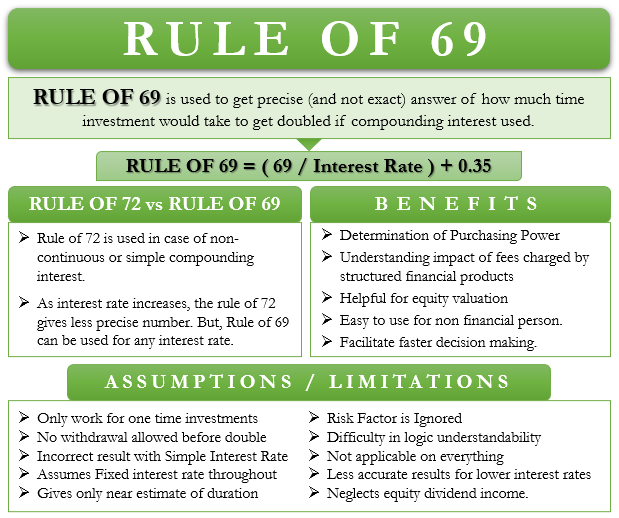Rule of 69: Meaning
Rule of 69 is a general rule that calculates how much time investment or saving would take to double in case of continuous compounding of interest. A point to note is that it doesn’t give a precise answer. Instead, a quick estimate of the impact of compounding on the investment amount, or we can say it is a rule of thumb.
The calculation is simple, as well. The advantage of using this rule is that one can get a quick idea of a potential investment without going into the detailed calculation by using a spreadsheet.
To calculate, all one needs to do is divide 69 by the given or expected investment rate of return. To get a more precise outcome, we should add 0.35 to the result. For example, a person wants to invest in a bank FD (fixed deposit), which gives a rate of return of 5%. In this case, amount will double in ((69 / 5) + 0.35 or 14.15 years.

Benefits of Rule of 69
The following are the advantages of using this general rule:
- We can use these rules to determine how quickly the purchasing power of a currency will halve at the time of inflation.
- These rules also help understand the impact of several types of fees that structured financial products charge, like Pension Plans, ULIPS, and mutual funds. These fees are management charges, entry and exit fees, mortality fees, administration charges, etc.
- Since the rule of 69 helps with continuously compounding, they are very helpful for equity valuation, where compounding is instant.
- We get a quick and almost accurate answer. Even a non-finance person can understand and calculate it.
- They are also seen as the thumb rule of the investment return.
- They facilitate faster decision-making.
Assumptions and Limitations
Following are the assumptions, as well as limitations
- These rules work only if the investment is one-time and not recurring.
- The investor must not take out part or full investment before it gets double.
- These rules assume a compound interest rate. We can say they don’t give the correct results in the case of the simple interest rate.
- The rate of interest must be fixed throughout the term.
- As said above, these rules do not give 100% accurate numbers. Instead, they give a near about estimate.
- These rules also do not consider the risk factor.
- The logic behind taking number 69 or 72 is difficult to understand.
- The 69 or 72 can’t be applied to everything.
- Results are less accurate when the interest rate is low.
- Projects where millions are at stake must not depend on these for decision-making. This is because where millions are at stake, even a minute difference could create a massive difference.
- One can apply the rule of 69 and 72 to equity. However, it neglects the dividends that equity investors get.
Important Points
Before you start to use the Rule of 69 and 72, you must be aware of these points:
- You must ensure whether the interest compounding is regular or anything different.
- If continuous compounding changes to normal compounding, it is wise to replace rule 69 with rule 72.
- A general rule is that the time it takes for an investment to double has an inverse relation with the interest rate. This means as the interest rate rises, the time period to double comes down.
- It would be best if you always kept in mind that the answer you get is not exact but rather an estimate.
Rule of 72 vs. Rule of 69
Just like Rule of 69, there is Rule of 72. However, the rule of 72 comes in handy in case of non-continuously or simple compounding interest. Also, it is useful when the interest rate is relatively low. As the interest rate rises, this rule gives a less precise number. We can use the Rule of 69 for any interest rate.
Also Read: Rule of 72 Calculator
Though the rule of 72 and 69 may appear similar, their results could be very different. The below table shows the result and the difference between the rule of 72 and 69 for the same interest rate:
| Interest Rate | Rule of 72 -No of Years | Rule of 69-No of Years |
|---|---|---|
| 5% | 14.40 Yrs | 14.15 Yrs |
| 9% | 8 Yrs | 8.02 Yrs |
| 14.50% | 6.25 Yrs | 6.35 Yrs |
| 23.50% | 3.06 Yrs | 3.29 Yrs |
As per the above table, the difference between the two is very marginal. Yet, a question that arises is which of the two is better? The answer is both. This is because both don’t give the precise result; rather, they are just quick near estimates, and both are approximations. Also, as said above, the rule of 72 gives better results when the interest rate is low.
There is another rule, called the Rule of 70, which comes in handy when using semi-annual compounding.
Financial planners and personal accountants are the ones that mostly use these techniques. This helps them manage their (and their clients’) finances and investments smartly.
Final Words
The rule of 69 is surely a smart way to calculate the time it takes for an investment to double. However, one must always remember that the resultant number is not precise. So, to get an idea of the time period, they are good, but for decision making, you must have an exact number.


Simple and easy-to-use financial literacy.
The rule is simple but quite complicated to apply for a newbie like me…. Please tell me which is the best investment for a beginner for a quick catch-up.